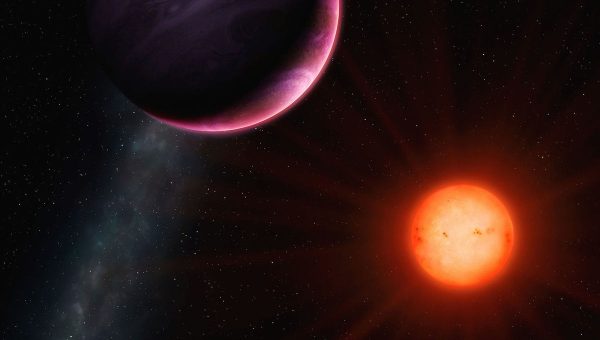An Earth-sized exoplanet found with a star that zooms *way* up and down in the Milky Way – SYFY WIRE

Artwork depicting a hot exoplanet orbiting a red dwarf star. Credit: University of Warwick/Mark Garlick
Contributed by
Mar 18, 2020
With over 4,000 exoplanets found so far, it takes a particularly interesting one to stand out.
. While most planet-bearing stars we find orbit the Milky Way in the plane of its disk, this planet’s host star’s orbit takes it well out of that plane, flying way up over the galaxy and way down below it over time, giving it a pretty interesting view of our galaxy.
First, the planet: It was found in TESS data, . This mission is surveying the entire sky, looking for planets around brighter stars. These tend to be closer to us, so TESS is finding planets that are in our neighborhood, galactically speaking.
is a red dwarf, a dim bulb of a star half the size and mass of the Sun, located about 97 light years away in the constellation of Pictor. It’s faint, radiating with only 4% the light of the Sun.
That’s still bright enough for TESS to see it, and find a planet orbiting it! The planet, called LHC 1815b, . It blocks a small amount of light from the star, creating a dip in its brightness, and that’s what reveals its presence. From the amount of light blocked, astronomers can measure the planet’s size, which is almost the same size as Earth: 1.088 ± 0.064 times our own diameter. So a smidgen larger.
The brightness of the star LHS 1815 dips by 0.05% every time its orbiting planet passes in front of it. Credit:
Very accurate spectra were taken of the star over time to determine the planet’s mass: As it orbits the star, the gravity of the planet tugs on the star; so while the planet makes a big circle the star makes a little one. . They found the planet’s mass to be 4.2 ± 1.5 times Earth’s, meaning this planet is possibly much denser than Earth — it has about 30% more volume than Earth, but may be over four times more massive. That right away is interesting to me: That is very dense, so I wonder if this was once a much larger planet with a dense core that suffered a huge collision, blasting away its outer layers, leaving the core behind. I’ll note the mass measurement is very uncertain, so it’s also possible the mass is much closer to Earth’s, and therefore the density similar.
Anyway, it orbits pretty close in to its star, with a “year” only 3.8 Earth days long. It’s only about 6 million kilometers from the star (that’s 1/25th the distance of the Earth from the Sun). The star is cooler than the Sun, but that’s close enough that the surface temperature is probably somewhere around the 350° Celsius (650°F) mark. So it’s hot, nearly enough to melt rocks. Not a fun place.
But it’s the star’s orbit that’s makes this system so very interesting.
The structure of the Milky Way: A flattened disk with spiral arms (seen face-on, left, and edge-on, right), with a central bulge, a halo, and more than 150 globular clusters. The location of the Sun about halfway out is indicated. Credit:
, a flat disk about 100,000 light years or more across (the exact size is still being argued over). It has a peanut-shaped central bulge, a cloud of stars roughly 13,000 wide light years across in the center, and a bar of stars in that shaped like a lozenge or a Tic Tac. The Sun orbits pretty much in the plane of the disk, a circle about 26,000 light years from the center.
We say the galaxy has a flat disk, but it’s more complicated than that. There are actually two disks, a thin one embedded inside a thicker one like a cake with a layer of frosting between the two sponges. is very roughly 1,000 light years thick, and more like 2,000. Mind you it’s not that simple — they aren’t solid objects; the number of stars fades out with height above the galactic midplane, like air in our atmosphere. It’s hard to simply characterize just how high above and below the galactic plane they go. The thick disk, for example, reaches many thousands of light years “up,” but very few stars in it actually get that far (just like our air is very thin at, say, 50 km above the ground, with very few air molecules at that height compared to sea level).
The two disks are physically different, too. Stars in the thin disk tend to be younger, and have more heavy elements (like iron) in them. The thick disk is older and heavy-element-poor, but it does have some structure in it; stars closer to the galactic center in the thick disk are younger than ones farther out.
Astronomers are still studying the thick disk to understand it. It’s not clear why we even have two disks, for example. Perhaps the thick disk formed when a smaller galaxy collided and merged with the Milky Way, or it built up over time with numerous smaller mergers.
The orbit of LHS 1815 is roughly circular when seen from above (top; note the x and y axis scales distort the plot) but from the side (bottom) it can be seen to be highly tilted, going well above and below the galactic plane (1 kpc = 3,260 light years). The red dot marks its current position. Credit:
Either way, it’s distinct from the thin disk, and that’s what makes LHS 1815 so very interesting. It’s motion through space, measured by the Gaia observatory, clearly show its orbit to be highly tilted with respect to the Sun’s. The orbit is slightly bigger, keeping it 28,000 light years from the galaxy’s center, but it can get up to 6,000 light years above and below the galactic plane!
That’s a long way. The Sun only gets a few hundred light years from the plane. When this star is at the top (or bottom) of its orbit it sees the galactic center from a much better angle than we have on it, about 12° above the plane. That would avoid a lot of the gas and dust in the disk, giving it a clearer view. I know a lot of astronomers who would give their left eyepiece to have that view!
Schematic of the position of LHS 1815 when it is high above the galactic plane; the angle from the center to it is about 12°, affording it a good view of the Milky Way’s heart. Credit: Phil Plait
This is the first thick disk planet found in TESS data, and hopefully many more will be spotted. Because the two disks are different there might be differences in the planets made by stars in them, but we’d need to find a lot of planets to know. Will they have different amounts of heavy elements, be bigger, smaller, or maybe just form at a different rate?
And mind you, if the thick disk is really from the Milky Way eating smaller galaxies, it’s possible LHS 1815 formed in another galaxy altogether! How’s that for a thought?
It’s incredible to think that exoplanets might tell us something about the history of our entire galaxy. But in science nothing stands on its own; it all weaves together one way or another. To see that, sometimes you need to take a step back — or up a few thousand light years — to see the whole thing.
Tip o’ the dark matter halo to .








